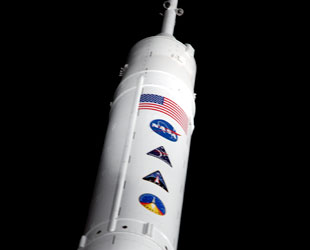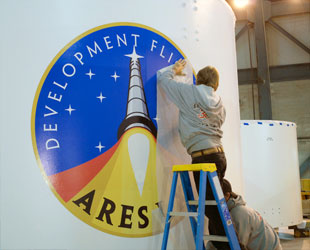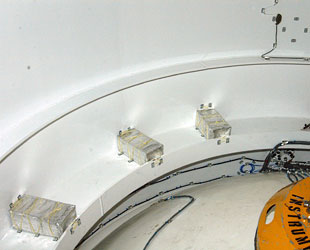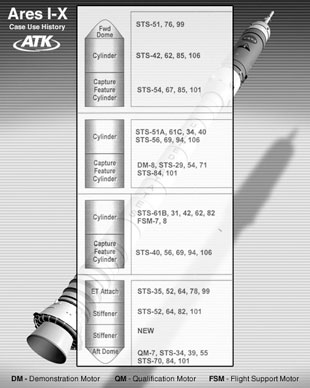October 26, 2009 — Hundreds of home videos along with thousands of miniature banners have been stowed aboard NASA's first test flight of a rocket designed to replace the space shuttle. Their journey onboard the Ares I-X will be lofted by a booster assembled from parts previously flown on 30 shuttle missions, including the launch of the Hubble Space Telescope.
Scheduled to lift off Tuesday morning, weather permitting, from a modified shuttle launch pad at the Kennedy Space Center in Florida, the Ares I-X development flight test will not enter space. Rather, the two-stage rocket will follow a 28-mile high, five-minute flight profile while more than 700 sensors record the vehicle's performance.
Only the Ares I-X first stage, a four-segment solid rocket booster borrowed from the shuttle program and amended with a simulated fifth segment to replicate the Ares I flight configuration, is to be recovered after it parachutes to an ocean splashdown. The second stage, which is made up of mockups including a simulated Orion crew exploration vehicle and launch abort tower, will be left to sink into the Atlantic.
As NASA's first opportunity to test a new rocket designed to carry astronauts to orbit, the primary goal of Ares I-X is to collect data needed to validate the agency's computer and wind tunnel models, while giving the team experience with preparing and handling a booster other than the space shuttle, which will be retired over the next year or two.
Dubbed the "first flight of a new era," the symbolic nature of the Ares I-X launch has not escaped NASA's attention.
From the top...
Standing 327 feet tall, Ares I-X is the tallest rocket now in service, rivaled only by the U.S. Saturn V and Soviet N-1 moon boosters last flown in the 1970s.

| The line of logos on Ares I-X's upper stage. (collectSPACE) |
Giving Ares I-X much of its height is its upper stage built from steel "tuna can" rings stacked atop each other and topped by empty replicas of the capsule and escape tower that would support an astronaut crew. Although it is to be lost at sea, this upper stage simulator (USS) also carries the most visible markings identifying the rocket as part of NASA's new Constellation program in the form of four six- foot emblems.
Positioned under an equally large American flag decal and below the NASA insignia are three emblems designed for the space agency by graphic artist Mike Okuda, who is perhaps best known for his design work on multiple "Star Trek" television series and movies. Though not the first of his emblems to fly on a spacecraft, Ares I-X will be the first vehicle to fly emblazoned with Okuda's Constellation, Ares and Ares I-X logos.
"I can't tell you how proud it makes me to help represent all the men and women who have worked so hard on this program and this flight test," shared Okuda in an e-mail to collectSPACE. "Honestly, I never expected to see any of these emblems on actual flight hardware, and it was a real thrill when I first learned that they'd be on this vehicle."
While the other logos may go on to fly on other rockets, at the bottom of the line of emblems is the blue, red, yellow, gold and white insignia that Okuda specifically designed for Ares I-X.
"The emblem is an attempt to illustrate the tremendous propulsive power required for space flight," he said of his design, which features a view from below Ares I-X as it lifts off. "[It] is intended to resemble the Ares project logo. However, the Ares I-X mission patch uses a circular background shape, to distinguish it from the rounded triangle used for the various [other] Constellation program emblems."

| Workers apply the Ares I-X logo to the side of the stage. (NASA) |
Above and behind the insignia decals inside the mockup crew capsule are markings of a different type, though also intended to represent the men and women who worked on the program.
"If you could go inside the rocket, most of the team at the very top of the crew module signed their name or left a message," Jon Cowart, Ares I-X deputy mission manager, revealed to collectSPACE. "I think my favorite one is 'Hello fishies, we come in peace.' So, when this thing hits the water and sinks to the bottom of the ocean, any of the literate fish will know."
...to the bottom
Though the team's signatures will be lost to the sea, they will not be without a memento of their work, added Cowart.
"We've also stowed on-board some flags," he said. "We've got enough in there to give most of the team members."
The 3,500 miniature banners were packed in the rocket's first-stage fifth-segment simulator, below the parachutes that will slow the splashdown and enable their recovery.

| The three packages of DVDs and flags inside Ares I-X. (NASA) |
Riding along with them are videos recorded on three DVDs that were submitted through NASA's website. The short films each feature members of the public completing the phrase, "Space exploration is important because..." as a social media demonstration.
Though NASA has collected and flown people's names on rockets before, this is believed to be the first home video collection to be launched.
The flags and DVDs, packaged inside three shoebox-size containers were carefully affixed inside the fifth segment.
"I know you're thinking, intuitively, 'It's just a couple of DVDs,'" Cowart said as part of a NASA interview, "but I assure you, objects smaller and lighter than DVDs have hampered missions before by falling in the wrong place at the wrong time."
Once brought back to land, the mementos will be pulled out of the rocket's first stage and mounted to plaques, although exactly when and where they will be distributed and/or displayed has yet to be established.
The rest of the first stage may be reused for future Ares flights, as is their legacy.

| Ares I-X case history. Click to enlarge. (ATK) |
Of the eleven cylinders and domes that comprise the four- segment solid rocket booster, only one is new. The other ten have been used to launch
30 prior shuttle flights.
Among the missions represented by the reused hardware are: STS-31, the 1990 deployment of the Hubble Space Telescope; STS-71, the 1995 first shuttle docking with the Russian Mir space station; and two International Space Station flights from 2000, STS-101 and STS-106.
The earliest-flown component, the third segment's upper cylinder, dates back 25 years to the first space salvage mission, STS-51A, aboard shuttle Discovery.
According to ATK, NASA's contractor for the solid rocket motors, the Ares I-X components will be re-serviced and reused just as they have before.
"The teams that handle this hardware from flight to flight take great pride making sure that the pieces are ready to fly again. It is just part of their culture that they love doing this," shared ATK vice president Michael Rudolphi.
